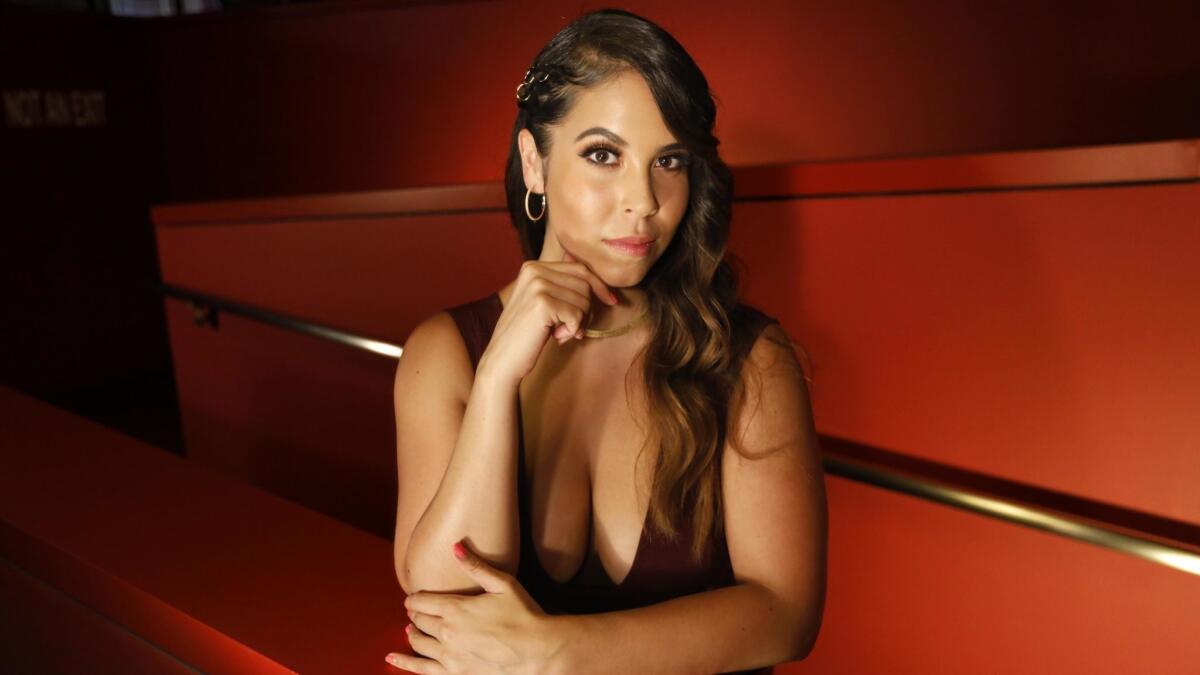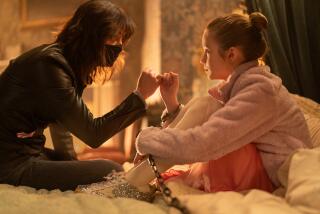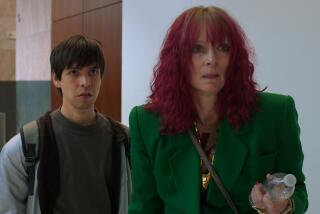Immigrant fears and the border crisis fuel fictional horror in Gigi Saul Guerrero’s ‘Culture Shock’

In director Gigi Saul Guerrero’s first feature, “Culture Shock,” co-written with James Benson and Efrén Hernández, Marisol (Martha Higareda) is pregnant and alone, and dreams of a better life for herself and her unborn child in the “land of opportunity,” America. She hires a coyote to get her across the border, but the group of immigrants with whom she makes the journey is caught. When she wakes up the following morning, with no memory of what happened the night prior, Marisol finds herself in a Pleasantville-like town, full of pastel and pastries, somewhere in the United States. Here, she is a new mom, with a creepy nanny (Barbara Crampton) who won’t let her touch the baby — and that’s only the beginning of the strange occurrences that pile up. Soon enough, events bear out Marisol’s suspicion that things aren’t what they seem, and what she once thought of as a land where dreams come true turns out to be a nightmare.
Against the all-too-real horrors of Immigration and Customs Enforcement raids and deportations, and the indefinite detention of undocumented immigrants, “Culture Shock,” which premieres July 4 as part of Hulu’s Blumhouse-produced horror anthology “Into the Dark,” doesn’t seem so outlandish. After all, Border Patrol has separated migrant families at the border, placed children as young as infants in cages, and allowed conditions to deteriorate to the point that some reportedly sleep on cold concrete floors and go without soap, toothbrushes or even, at times, warm meals to eat. Recent descriptions of detention facilities at the border have provoked comparisons to Japanese internment camps and the concentration camps built by Nazi Germany, and yet migrants continue to make the trek, despite the risk of imprisonment or death. Their struggles in their home countries may outweigh the potential hazards the journey across the border entails, and as Marisol believes, some migrants feel the chance is worth taking for a better life — if not for themselves, for their children.
Meanwhile, Hollywood still has a long way to go when it comes to racial and gender equality, and one of the biggest gaps in representation is suffered by the Latinx community. Only 6% of speaking roles in the top 100 movies at the box office go to Latinx characters, according to USC’s Annenberg Inclusion Initiative, while Latinx people make up more than 18% of the U.S. population. Which is what makes “Culture Shock,” with its large Latinx cast and crew and distinctive, timely subject matter, an important glimpse into what Hollywood is capable of grappling with when Latinx people are adequately represented.
Shortly before the Los Angeles premiere, in between makeup applications, hair styling and a couple of doting, proud parents, we spoke with Saul Guerrero over the phone about the rise of bilingual film and TV and the 18 short films she made before “Culture Shock.”
The subject of your film is very timely, in light of the situation at the border. You’re a Canadian citizen and an immigrant from Mexico. What do you have to say about the timeliness of the film and your outlook on what’s going on at the border?
Unfortunately, it is really timely. But in another way, I feel it’s time to really recognize what is happening at the border and in our world in general. It’s hard to explain because it’s such an angry situation and really hard to put words together about it. I hope and encourage that this film at least begins a conversation. It’s very hard to help what’s happening, but if we can at least talk about it, and at least recognize how awful the situation is, we’re taking a big step forward.
When I was on set, I watched you direct a scene in Spanish, casually flipping back and forth from Spanish to English and vice versa. I have been on many sets, and it was the first time I had ever witnessed something like that. It was amazing to witness.
You know, that was not even planned. It just happened so organically, so naturally. Just talking to the actors in Spanish, we all understood the message we’re portraying with the film. So between us, we would really connect in our native language, and that doesn’t happen often. And the crew felt like they were really stepping into this authentic representation of “culture shock.”
The film is bilingual as well: Close to half of it is in Spanish. Between TV shows like “Jane the Virgin” and “One Day at a Time,” last year’s Oscar contender, “Roma,” and last week’s Democratic primary debates, in which several candidates made it a point to speak in Spanish, does it feel like the tide is changing a little for how people react to hearing Spanish? Or do you think it’s born out of necessity, with creatives wanting to show Latinos in a more humane, less stereotypical light?
I think it’s a combination of both. We’re living in a good time right now where things are talked about. We’re starting to really challenge our audiences. We don’t spoon-feed anybody anymore. Like, who would have thought a movie like “Roma,” in black and white, on Netflix, and in Spanish, would go to the Oscars? You put that movie out 10 years ago, no one would have given a … about it. I think people are now really speaking up for what’s right, and we’re challenging the audiences. I’m just so happy that the studio agreed to that decision when I said, “This has to be in Spanish and we have to make it as authentic as possible.” It’s important to keep encouraging all Latinx content to be as authentic as possible. But we can’t do that unless we hire Latinx writers and directors.
As a Latina filmmaker, do you feel a little bit of a responsibility to tell these authentic stories, or at times do you feel you get pigeonholed into only telling “Latinx” stories?
I do, at times, feel like I only get considered for what [are] considered Latino stories. I am an actress too, and I almost never get a chance to read for a non-Latinx type of role. But I also feel that it’s the filmmaker’s responsibility to connect to a story, whatever it’s about. If you connect to a story, that story is meant for you to tell. In the case of my film, I feel angry about what’s happening in our world and the border crisis. I feel that this was my responsibility to take into my hands. It’s the mix of both. What is that story you need to tell right now? What is in your heart right now to do?
One of the biggest conversations going on in Hollywood right now is the lack of female directors, and even more so the lack of women of color directors. What has your experience been trying to get your foot in the door as a Latina filmmaker?
It’s been tough, for sure, but I like to look at it as an advantage, you know — being different, being Latina, being female. I always look at that as an advantage, not just to stand out, but as an advantage to push myself to work harder. That’s been really my focus, because it has been really tricky to get the recognition. It’s taken me 18 short films to get here. That’s a lot of shorts, you know? It’s been really important to me since the beginning to be true to where I come from. So all my content has some sort of really cool twist that really feels like me and really feels like I’m being true to who I am. That’s been my goal.
What do you hope viewers, especially those that aren’t necessarily watching content made by Latinos, come away feeling or thinking once they see ‘Culture Shock’?
God. I have so many emotions. I hope they come away thinking that this is a story that they could share with everybody they know. It’s not just for Latinos. It’s really meant for everybody. This movie is important because it’s gonna show true unity of humans ... [it’s] not going to come across like “Latinos versus the USA.” Without giving anything away, I really wanted to use the Fourth of July holiday to be, like, this celebration of true freedom and true pride. I hope people leave not just being entertained, but with a deep, deep, open heart to the border situation, and to share with others about what they felt and learned when they watched. That would be the best compliment I could get.
More to Read
The complete guide to home viewing
Get Screen Gab for everything about the TV shows and streaming movies everyone’s talking about.
You may occasionally receive promotional content from the Los Angeles Times.






